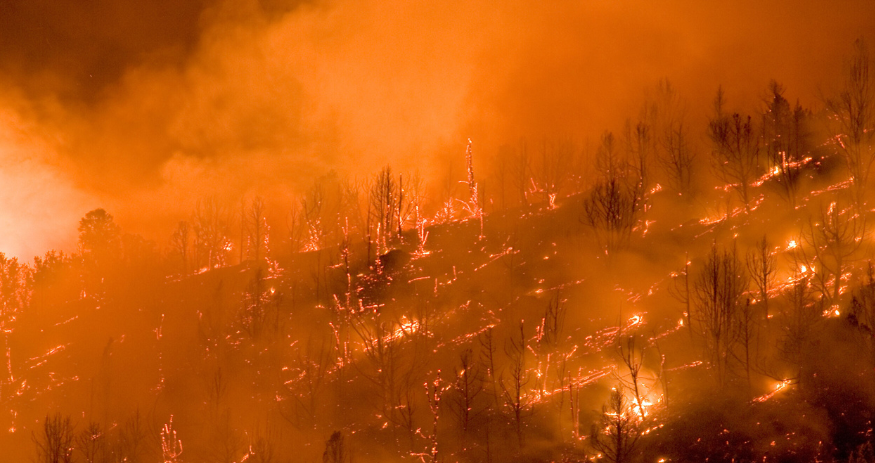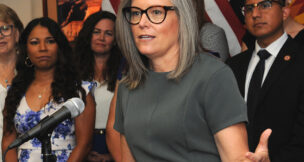Governors prod Congress for more help on growing threat of wildfire in West
Kelechukwu Iruoma, Cronkite News//September 11, 2024//[read_meter]
Governors prod Congress for more help on growing threat of wildfire in West
Kelechukwu Iruoma, Cronkite News//September 11, 2024//[read_meter]
WASHINGTON – Arizona Gov. Katie Hobbs and 19 other Western governors are prodding Congress to move more urgently to address a wildfire crisis that has grown worse in recent years.
In Arizona last year, 1,837 fires burned 188,483 acres, according to the Arizona Department of Forestry and Fire Management. This year’s total is already worse: 1,704 fires on 252,929 acres, officials said, and the wildfire season isn’t over.
In 2020, 2,447 wildfires burned 980,308 acres of state, federal and tribal lands in Arizona alone – about the size of Rhode Island. Other Western states have been similarly ravaged.
“The wildfire crisis will not abate without congressional support for aggressive intervention,” reads the letter signed by New Mexico Gov. Michelle Lujan Grisham, a Democrat who chairs the Western Governors’ Association; and Utah Gov. Spencer Cox, a Republican who serves as vice-chair.
Congress created a Wildland Fire Mitigation and Management Commission in 2021 to recommend improvements to wildfire management. Few of the recommendations the panel issued a year ago have been implemented.
The report called the crisis “immense,” and urged Congress to shift its mindset from fire response to proactive measures, such as “retrofitting structures to resist ignition, thinning vegetation near communities, or managing forests and grasslands.”
“The reactive approach of our current system is not only incredibly costly, but also does little to mitigate overall wildfire risk,” the panel wrote.
The panel also urged Congress to provide dedicated funding to compile and evaluate wildfire hazard data, and suggested federal standards to reduce the risk of sparks from power lines.
With little sign of urgency in Congress since the report was issued, the governors expressed frustration.
“The cost of inaction is unacceptable: high-severity, catastrophic wildfire and its aftereffects, including post-fire flooding and health-related smoke impacts, kills thousands of Americans every year and has permanently altered a large number of landscapes,” the governors wrote in their letter to congressional leaders of both parties. “We must act now to prevent permanent, widespread loss of our nation’s most critical natural assets and the communities that depend upon them.”
Wildfires have destroyed tens of thousands of structures and threatened nearly 2,000 communities in dozens of states in the last 24 years, according to the commission report.
These fires – “fueled by a legacy of forest mismanagement and driven in part by a changing climate,” according to the WGA letter to Congress – have been increasingly destructive and frequent, threatening lives and animal populations, and destroying livelihoods.
Western states contain over 75% of national forest and grassland, the WGA noted.
The Forest Service, part of the U.S. Department of Agriculture, shares responsibility for wildfire response and management across federal lands with the Department of the Interior.
Through Tuesday, the National Interagency Fire Center reported that 24,163 firefighters and support personnel were actively fighting 71 large wildfires. So far this year, the agency said, wildfires have burned 2,247,356 nationwide.
John Truett, fire management officer at the Arizona Department of Forestry and Fire Management, said wildfire management officers are overwhelmed.
“We’re seeing more fire across the landscape, but our abilities to suppress these fires are limited by resource availability,” he said by phone. “We don’t have the workforce we used to have. And combine that with the environmental conditions being the way they are.”
In 2022, Congress provided $7.5 billion for wildfire response, split between the Forest Service and Interior Department. That included $1.8 billion in emergency funds.
In 2023, the outlay for wildfire response was $7.2 billion.
“We’re short of fire engines, hand crews, just overall firefighting equipment, and firefighters and managers that provide the leadership and the direction on the ground during the firefight,” Truett said.
He echoed the commission’s philosophy that effective wildfire management requires long-term budgeting and better planning, not just more resources to suppress fires once they start.
“It’s a long-term solution that will take 20 to 30 years,” he said.
Jonah Seifer, senior policy advisor at the Western Governors’ Association, said the wildfire crisis is top of mind for state leaders.
“It’s a profound threat to all Americans, even if you don’t live in a fire-prone landscape,” he said. “Western states have a unique interest in addressing the wildfire crisis, partly because of the large presence of federal lands in the West.”
“The risk is a widespread loss of some of our nation’s most critical natural resources, as well as the communities that depend on them,” he said.
Steve Conboy, founder and president of Mighty Fire Breaker, a company that sells fire management products, agreed that the U.S. government needs to move more quickly.
“It’s going to hurt the real estate market. It will hurt the housing starts, and builders can’t get permits,” he said. “We need them on Capitol Hill to look at this hard because we need to help save American property owners.”


















